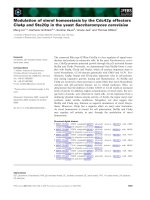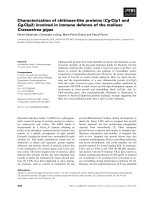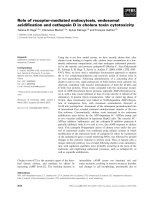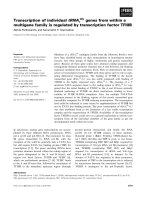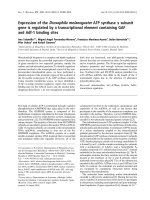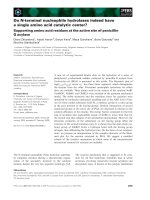Báo cáo khoa học: Biosynthesis of platelet glycoprotein V expressed as a single subunit or in association with GPIb-IX doc
Bạn đang xem bản rút gọn của tài liệu. Xem và tải ngay bản đầy đủ của tài liệu tại đây (320.32 KB, 7 trang )
Biosynthesis of platelet glycoprotein V expressed as a single subunit
or in association with GPIb-IX
Catherine Strassel, Sylvie Moog, Marie-Jeanne Baas, Jean-Pierre Cazenave and Franc¸ois Lanza
INSERM U.311, Etablissement Franc¸ ais du Sang-Alsace, Strasbourg, France
Glycoprotein (GP) V is noncovalently linked to GPIba,
GPIbb and GPIX within the platelet GPIb–V–IX complex,
a receptor for von Willebrand factor and thrombin. Two
functions have been ascribed to GPV, namely, the modula-
tion of thrombin- and collagen-dependent platelet responses.
The biosynthesis of this molecule was investigated in pulse–
chase metabolic labelling experiments performed in CHO
cell lines transfected with GPV, alone or in the p resence o f
GPIb–IX. GPV could not be detected at the surface of cells
expressing the single subunit but was f ound instead as a
soluble f orm i n the culture m edium. In pulse–chase studies,
an immature 70 kDa protein was detected in cell l ysates,
whereas a fully processed 80–82 kDa form was only
observed in the culture supernatants at later chase times.
Immature GPV w as N-glycosylated and r etained before the
medial Golgi while the secreted molecule contained c omplex
sialylated sugars. The mature soluble form of GPV was
produced by an enzymatic cleavage wh ich w as not affected
by inhibitors of proteasome, calpain or metalloproteinases.
When GPV was cotransfected with GPIb–IX, the former
was no longer found in the c ulture supernatant but was
retained in the cell m embrane as shown by fluorescence-
activated cell sorting and confocal microscopy analyses.
Surface expressed GPV was processed from an immature
70 kDa form to produce a mature 80 kDa protein, pro-
cessing similar t o the intracellular trafficking of GPIb a.
These results indicate that correct biosynthesis and surface
expression of GPV in platelets requires the presence o f the
other s ubunits of the G PIb–V–IX complex.
Keywords: biosynthesis; CHO; glycoprotein; glycosylation;
platelet.
The platelet G PIb–V–IX complex p lays an essential role in
the f ormation of the haemostatic plug following vessel w all
injury [1]. This cell surface receptor is r equired above a ll
under the conditions of high shear stress encountered
in arteries and microvessels, where it mediates reversible
platelet adhesion by binding to von Willebrand factor
(vWF) exposed on the damaged vessel w all [2]. T he
functional importance of the GPIb–V–IX complex is
highlighted by th e existence of the Bernard–Soulier bleeding
syndrome, in which the complex is p resent in strongly
decreased amounts or in more rare cases is not functional.
GPIb–V–IX is composed of four different type I glycopro-
teins: G PIba,GPIbb, GPIX and GPV, al l b elonging t o t he
Ôleucine-ric h repeat family Õ [3]. GPIba (135 kDa) is disul-
phide-linked to GPIbb (25 kDa) and noncovalently com-
plexed with GPIX (20 kDa) and GPV (82 kDa) in a
2 : 2 : 2 : 1 s toichiometry [4,5].
Several f unctions have been proposed for glycoprotein
(GP) V . It could act as a negative regulator of thrombin
activation [6], or as an a ccessory receptor for collagen
dependent platelet adhesion and a ctivation [7]. Although i t
has not yet been d emonstrated, GPV could potentially play
a role in platelet signalling during adh esion to vWF. Thus,
14–3-3f [8,9] and the calcium dependent regulator calmo-
dulin [10] have been shown to b ind to t he cytoplasmic
domain o f G PV. A distinctive f eature of this molecule is its
extreme sensitivity to cleavage by proteases. After throm-
bin-induced platelet activation, cleavage of GPV at a
specific site releases a soluble 69 kDa fragment (f1) [11],
the physiological significance of which is still unknown.
In addition, GPV can be cleaved by elastase to release a
75 kDa fragment and by calpain, at a site near the cell
membrane, to generate an 82 k Da fragment [12]. Despite its
association with the other subunits of the GPIb–V–IX
complex, GPV is more loosely attached [4] and does not
appear to be essential for the normal expression o f these
subunits. GPIb–IX is expressed e fficiently in transfected
cells in the absence of GPV and in the platelets of GPV
knock-out mice [13–15]. This is consistent with the obser-
vation that al l the reported B ernard–Soulier defects are
restricted to the GPIba,GPIbb and GPIX subunits [16].
Nevertheless, s ome studies in transfected cells have indicated
that GPV could enhance levels of expression of the complex
at the platelet surface [17].
The available biosynthetic studies of receptors restricted
to platelets (GPIb, GPIIbIIIa) have essentially relied on
their expression in heterologous cells. A pproaches of this
type have improved our understanding of the requirements
for normal biosynthesis of the GPIb–IX complex and of the
consequences of mutations encountered in Bernard–Soulier
patients [18]. T hese studies were, however, performed mostly
in the absence GPV. On the contrary, the biosynthesis of
Correspondence to F. Lanza, INSERM U.311, Etablissement Franc¸ ais
du Sang-Alsace, 10 rue Spielmann, BP 36, 67065 Strasbourg Cedex,
France. Fax: +33 388 21 25 21, Tel.: +33 388 21 25 25,
E-mail:
Abbreviations: Endo-H, endoglycosidase-H; FACS, fluorescence-
activated cell sorting; FITC, fluorescein isothiocyanate; GP,
glycoprotein; SV40, simian virus 40; vWF, von Willebrand factor.
(Received 20 April 2004, revised 21 June 2004, accepted 26 July 2004)
Eur. J. Biochem. 271, 3671–3677 (2004) Ó FEBS 2004 doi:10.1111/j.1432-1033.2004.04304.x
GPV has never been thoroughly i nvestigated. A better
knowledge of the processing of GPV i s likewise necessary to
obtain greater ins ight into i ts str uctural and f unctional r ole
in platelets. To address t hese questions, w e have developed
two heterologous expression cell systems where GPV was
transfected in the presence or absence of the other three
subunits of the GPIb–V–IX complex, allowing study of its
biosynthesis and cellular distributio n.
Experimental procedures
Materials and cell lines
The mAbs V.1 and V.5 ag ainst GPV, ALMA.12 against
GPIba, ALMA.16 against GPIX and RAM.1 against
GPIbb, were developed in our laboratory [19]. CHO cell
lines CHO-K1 and CHO-DUK (deficient in dihydrofolate
reductase) were purchased from ATCC (Rockville, MD,
USA). The CHO/GPIb–V–IX cell line was derived from a
clone expressing GPIbb and GPIX (gift from J. A. Lopez,
Baylor College of Medicine, Houston, TX, U SA) by
transfection with cDNAs coding for GPIba inserted in the
pDX vector [20] and GPV inserted in the pZeoSV vector
(Invitrogen, San Diego, CA, USA) and selection in the
presence of zeocin. These cells were grown in aMEM (Gibco
BRL, Cergy-Pontoise, France) supplemented with 10%(v/v)
fetal bovine serum, 200 lgÆmL
)1
zeocin and 400 lgÆmL
)1
G418 (Boehringer–Mannheim, Germany). The CHO/GPV
cell line was obtained by transfection of CHO-DUK cells
with GPV cDNA inserted in the pTG2328 vector, selection in
the absence of nucleosides and a mplification of GPV
expression by growing c ells in the presence of step i ncreased
concentrations of methotrexate [21]. This clone was main-
tained in suspension in s erum fre e CHO-S-SFMII mediu m
(Gibco BRL) supplemented with 1.2 lgÆmL
)1
methotrexate
(Calbiochem Novabiochem, La Jolla, CA, USA). Expres-
sion in pZeoSV and pTG2328 is driven by the simian virus 40
(SV40) early enhancer/promoter.
Flow cytometry
CHO cells (2 · 10
5
in 100 lL) were incubated for 30 min at
4 °C with purified IgG (10 lgÆmL
)1
) in fluorescence
microfluorimetry buffer [RPMI medium, 5% (v/v) normal
goat serum, 0.2% (v/v) sodium azide]. After centrifugation
at 270 g, the cells were resuspended in buffer containing a
100-fold dilution of fluorescein isothiocyanate-(FITC)-con-
jugated g oat a nti-(rat I gG) F( ab¢)
2
or FITC-conjugated
goat anti-(mouse IgG) IgG (Jackson Immunoresearch,
West Baltimore, PA, USA) for 30 min at 4 °C. Analyses
were performed on 10 000 cells in a FACS Calibur flow
cytometer (BD Biosciences, Rungis, France).
35
S metabolic labelling
CHO cells (2 · 10
8
ÆmL
)1
) were incubated t wice in 50 mL of
cysteine- and methionine-free RPMI medium (ICN, Costa
Mesa, CA, USA) without serum for 30 min at 3 7 °C. The
cells were then pulse-labelled for 15 min a t 37 °C
in the same medium containing 1% (v/v) penicillin–strep-
tomycin–glutamine (Gibco), 20% (v/v) dialysed f etal bovine
serum (Biowest, Nuaille, France) and a mixture of
[
35
S]methionine and [
35
S]cysteine (Amersham Pharmacia
Biotech, Uppsala, Sweden). The labelled c ells were diluted
in 10 volumes of ice-cold NaCl/P
i
, washed once and chased
for different times at 37 °C. At each chase time, cell samples
were washed twice in i ce-cold NaCl/P
i
and l ysed in buffer I
[20 m
M
Tris (pH 7.5), 150 m
M
NaCl, 5 m
M
EDTA, 0.2%
(w/v) BSA, 1% (v/v) Triton X-100, 1· complete protease
inhibitor cocktail, 2 lgÆmL
)1
calpain inhibitor (Roche
Diagnostics GmbH, Mannheim, Germany)].
Immunoprecipitation and SDS/PAGE
Lysates corresponding to 3 · 10
7
cells from suspensions
containing 5 · 10
6
cellsÆmL
)1
and 2 mL culture superna-
tants corresponding to 10
7
cells were clarified by incubating
them twice for 1 h at 4 °Cwith100lLofprotein
G-Sepharose (Sigma, Saint L ouis, MO, USA). The s amples
were then in cubated overnight at 4 °Cwith10lgofthe
relevant mAbs and 100 lL of fresh protein G-Sepharose.
After centrifugation, the bead pellets were washed once in
buffer I, t wice in buff er II [ 0.5% (v/v) T riton X-100, 20 m
M
Tris (pH 7.5), 150 m
M
NaCl, 5 m
M
EDTA, 0.2% (w/v)
BSA, 0.1% (w/v) S DS], three times in buffer I II [0.5% (v/v)
Triton X-100, 20 m
M
Tris (pH 7 .5), 500 m
M
NaCl, 5 m
M
EDTA, 0.2% (w/v) BSA] and twice in buffer IV [50 m
M
Tris (pH 7.5)]. The beads were resuspended in Laemmli
buffer containing 10 m
M
dithiothreitol and heated f or
5 m in at 95 °C. Prot eins wer e separated b y 7 .5–15%
gradient SDS/PAGE and the gels were fixed and processed
for autoradiography.
Carbohydrate analyses
After the last washing step in buffer IV, the immunopre-
cipitates were dissociated from the beads in 30 lLof50m
M
Tris (pH 7.5) containing 1% (w/v) SDS and 5 m
M
dithio-
threitol and boiled f or 5 min at 95 °C. Sodium citrate
(pH 5.5) was added to a final concentration of 0.1
M
.The
samples were then incubated with endoglycosidase-H
(5 mU per sample) for 6 h at 37 °C in t he presence of
1.7 lgÆmL
)1
calpain i nhibitor and 1· protease inhibito r
cocktail. In neuraminidase treatment, the beads were
resuspended directly in 20 lL of 100 m
M
sodium acetate
(pH 5) containing 1 m
M
CaCl
2
and 150 m
M
NaCl, before
addition of 10 lL of n euraminidase (100 mUÆmL
)1
)
(Roche) and incubation for 6 h at 37 °C.
Western blotting
Supernatants from CHO/GPV cell cultures w ere treated o r
not with thrombin (5 UÆmL
)1
) (Sigma) for 5 min at 3 7 °C,
before separation by 4.5%)15% SDS/PAGE and immu-
noblotting. The blots were probed with the mAb V.5
followed by goat anti-(mouse IgG)–horseradish and p rotein
bands were revealed by ECL (Amersham Biosciences, UK).
Confocal microscopy
CHO cells seeded at 20.10
4
cellsÆmL
)1
in NaCl/P
i
were
allowed to adhere to poly
L
-lysine-coated coverslips in f our-
well plates for 2 h at 37 °C. After washing, the cells were
fixed with 3% (w/v) paraformaldehyde and permeabilized
3672 C. Strassel et al.(Eur. J. Biochem. 271) Ó FEBS 2004
with 0.05% (w/v) saponin in blocking solution [NaCl/P
i
containing 0.2% (w/v) BSA and 1% (v/v) goat serum].
CHO/GPIb–V–IX cells were incubated for 45 min at room
temperature with the mAb V.1 in blocking solution, washed
and incubated with a GaM–Cy5 secondary antibody
(Jackson Immunoresearch) for 30 min. These cells were
then incubated for a further 30 min with a 1 : 400 dilution
of a third antibody (ALMA.12 or ALMA.16) directly
coupled to Alexa-488 (Molecular Probes, Eugene, OR,
USA). CHO/GPV cells were incubated w ith V.1 coupled
directly to Cy3 for 45 min at room temperature. The
coverslips were washed in NaCl/P
i
,rinsedinwaterand
mounted in Mowiol 4-88 (Calbiochem Novabiochem) and
the labelled cells were examined under a Zeiss laser scanning
microscope (LSM 410 invert) equipped w ith a Planapo oil
immersion lens.
Results
Transfection of GPV in the absence of GPIb–IX results
in its inefficient cell surface exposure and release
of a soluble form of GPV
The CHO/GPV cell line transfected with full length GPV
lacked surface expression of GPV as m easured by flow
cytometry (Fig. 1A), despite selection of a strongly
expressing clone by a series of amplifications in the
presence of increasing concentr ations of metho trexate.
Analysis of permeabilized cells by confocal microscopy
revealed an intracellular pool of GPV with a granular
appearance (Fig. 1B). Analysis of culture supernatants by
GPV ELISA showed the presence of high levels o f soluble
GPV [21], which was identified a s a single 82 kDa band by
Western blotting with t he mAb V.5 (Fig. 1C). The identity
of t his band was f urther established by its cleavage to a
69 kDa species following thrombin treatment. These
properties of s oluble recombinant GPV are identical t o
those reported for a calpain-derived fragment of platelet
GPV [12].
Singly transfected GPV is retained intracellularly as an
N-mannose rich 70 kDa form and is released into the cell
supernatant as a sialylated 82 kDa polypeptide
Pulse–chase and immunoprecipitation experiments were
performed on CHO/GPV cell lysates and culture super-
natants (Fig. 2A). A broad 70 kDa band corresponding to
immature GPV w as present in the cells at early time points
and throughout 180 min of chase, w hile shorter chase times
revealed that this band was composed of three or four
different m olecular mass f orms. Parallel a nalysis of the
supernatants revealed a positive signal starting at 60 min of
chase a nd having a molecular mass (82 kDa) consistent with
a f ully mature form. This b and was not observed in the cell
lysates a t a ny chase time a nd conversely the 70 kDa band
was absent from the supernatants.
Fig. 1. Distribution o f GPV in CHO/GPV cells in the absence of GPIb–IX. (A) G PV expression on the surface of platelets and CHO/G PV cells was
analysed by flow cytometry using the mAb V.1 without p ermeabilization of the cells. A positive signal was observed on platelets but n ot on CHO/
GPV cells. (B) The subcellular distribution of GPV was examined in permeabilized CHO/GPV cells by confocal microscopy using Cy3-coupled V.1.
An intracellular l abelling was obser ved w ith a granular appearance. (C) Soluble GPV in the supernatants of CHO/GP V cells was analysed by
Western blotting with the mAb V.5. An 82 kDa band was detected in untreated samples, which was converted into a 69 kDa band by treatment
with 5 UÆmL
)1
thrombin.
Ó FEBS 2004 Biosynthesis of platelet glycoprotein V (Eur. J. Biochem. 271) 3673
Post-translational s ugar modifications of the cellular and
soluble forms of GPV were studied by treatment with
endoglycosidase-H (Endo-H) (Fig. 3A) or neuraminidase
(Fig. 3 B). The 70 kDa form was sensitive to Endo-H
treatment, which reduced it to a narrow 5 0 kDa band, but
was not cleaved by n euraminidase. T his i ndicated i ts
enrichment in N-mannose sugars added before the medial
Golgi compartment. On the other hand, the 82 kDa soluble
molecule was resistant to Endo-H an d cleaved by neura-
minidase to a 72 kDa form, indicating the p resence o f
terminal sialic acid residues added in t he trans-Golgi. These
experiments s how that the secreted 82 kDa f orm of GPV is
fully processed during transit through the different Golgi
compartments b ut is not retained in the p lasma membrane.
In the presence of the GPIb–IX complex, GPV is fully
processed and targeted mainly to the cell surface
Contrary to the singly transfected subunit, GPV cotrans-
fected with GPIb–IX was efficiently expressed at the cell
surface t ogether with the other subunits of the G PIb–V–IX
complex, as demonstrated by flow cytometry (Fig. 4A).
Double-labelling confocal m icroscopy with antibodie s
against GPV and GPIba or GPIX revealed colocalization
of these s ubunits with G PV primarily at the cell m embrane.
Hardly any labelling c ould be detected intracellularly, unlike
in CHO/GPV cells (Fig. 4B). These results imply that
GPIb–IX is required for stable surface expression o f GPV in
transfected cells. Very comparable results were obtained
when GPV was cotransfected with GPIb–IX i nto leukaemic
human K562 cells. This cell line was chosen for biosynthetic
studies in order to analyse the processing of GPV in a cell
system more closely resembling platelets. Pulse–chase
experiments performed on cell extracts alone showed
immunoprecipitation at early times of the immature
70 kDa form of GPV, which progressively matured to a
cell associated 82 kDa protein. C oncomitantly, GPIba
progressed from an immature 85 kDa form to a mature
125 kDa mo le cule. GPIbb and GPIX displayed more
modest mass increases of 1–2 kDa and gradually reached
their mature sizes of 25 and 20 kDa, respectively, ove r
30 min of chase. This maturation time-course is very similar
to that reported p reviously for C HO/GPIb–IX cells [18,22]
(Fig. 4 C). Analysis of t he supernatants revealed no secreted
forms of GPV (data not s hown), while the m ature GPV in
K562/GPIb–V–IX c ells was sensitive to neuraminida se
treatment but resistant to Endo-H (data not shown).
Discussion
Using stably transfected cell lines, we examined the biosyn-
thesis of platelet GPV, a subunit of the GPIb–V–IX
Fig. 2. Biosynthesis of GPV in CHO/GPV cells in the absence of
GPIb–IX. CHO/GPV cells were pulse-labelled with [
35
S]Cys and
[
35
S]Met a nd chased for various periods of time. A t different chase
times, the c ulture supernatants were collected, the cells were lysed in
Triton X-100 buffer and the cell lysates and s upernatants were ana-
lysed by immunoprecipitationwiththemAbV.1.AtT
0
,thecells
contained an immature 70 k Da form of GPV which did not appear to
progress to a higher molecular mass form during the 180 min of chase.
On the o ther hand, an 80 kDa mature form progressively appeared
and accumulated in the s upernatants at c hase times o f 60–120 min.
Because a t T
0
only th e 7 0 kDa form is present it must be the p rede-
cessor of the 80 kDa soluble form. The 70 kDa form th eref ore matures
but probably becom es quickly se creted and do es not accum ulate in
sufficient amounts to allow detection in t he cell lysate.
Fig. 3. Sugar processing of cell associated and sec reted forms of GPV in
CHO/GPV cells. Cells were pulse-labelled, c hased and immun opre-
cipitated as described in Fig. 2 and th e immunoprecipitates from the
cell lysates or supernatants were analysed for Endo-H (A) or neura-
minidase (B) sensitivity. (A) The band at 70 kD a corresponding to
immature cell associated GPV was converted into a 50 kDa band (the
expected siz e of deglycosylated G PV) b y End o-H treatment. In con-
trast, the 80 kDa secreted molecule was i nsensitive to Endo-H. (B) The
cell associated 70 kDa form o f GPV was resistant to neuraminidase,
whereas th e solu ble 80 kDa fo rm was reduced to 70 kD a t hrough loss
of terminal s ialic acid res idues.
3674 C. Strassel et al.(Eur. J. Biochem. 271) Ó FEBS 2004
complex, and the influence on its pro cessing and expres-
sion of the presence or absence of the other subunits of
the complex. In both cases, GPV was processed from
an immature mannose-rich intracellular 70 kDa form to
a mature sialic acid-rich 82 kDa species. Mature GPV
was expressed efficiently at the cell surface in the presence
of GPIb–IX, whereas singly t ransfected GPV w as secreted
as a soluble m olecule, presumably following enzymatic
cleavage.
A lack of surface expression of GPV after single-chain
transfection was unexpected in view of the presence of a
transmembrane region in the construct e ncoding the entire
protein and from previous reports of its surface expression
in human melanoma cells and mouse L-cells stably trans-
fected with GPV alone [17]. Cell membrane expression of
GPV has also been observed in CHO cells in transient
expression experiments [14]. In our studies, using CHO cells
or a human K562 leukaemic cell line, low levels of GPV
were detected at the cell membrane 48–72 h aft er transfec-
tion but we were never a ble to obtain a stable surface
expression. Lack of expression in C HO/GPV cells is
probably not related to differences in expression vectors
compared to CHO/GPIb–V–IX, as both vectors contain the
same SV40 promoter. This was also not due to i nefficient
biosynthesis of GPV a s C HO/GPV cells were submitted to
extensive gene amplification with methotrexate resulting in a
80-fold increase i n concentrations of soluble GPV. Ampli-
fication of GPV expression probably explains part of the
intracellular a ccumulation observed i n CHO/GPV cell lines
in confocal microscopy and metabolic labelling experi-
ments. Although differences with respect to a few studies
could be related to the cell types used, i n general the single
subunit is not (or only v ery weakly) retained at the cell
surface. Consistent with this hypothesis, sign ificant levels of
Fig. 4. Surface expression and intracellular processing of GPV in CHO and K562 cells c otransfected with GPV and GPIb-IX. (A) CHO cell s stably
transfectedwithGPV,GPIba,GPIbßandGPIXwereanalysedforsurfaceexpression of GPV b y flow cytometry. A positive GPV signal was observed
with approximately half the intensity of those of the other subunits. (B) CHO/GPIb–V–IX cells adherent to poly
L
-lysine were permeabilized, double-
labelled with m Abs against GPV (pink) and GPIba (green) (left panel) or GPV ( p ink) and GPIX (green) (right panel) and analysed by confocal
microscopy. Co-localization at th e c ell membrane (white) wa s o bserved under both co nditions. (C) K562/GPIb–V–IX cells w ere pulsed-labelled with
35
S and ch ased as described in Fig. 2. At d ifferent chase time s, the cells were lysed in 1% ( v/v) Triton in buffer I and the GPIb–IX complex was
immunoprecipitated with ALMA.12 and GPV with V.1. At T
0
, the cells contained a n immature 70 kDa form of GPV which progressed within 60 min
to an 80 kD a mature protein . GPIba progressivel y evolved from an early immature 85 kDa form to a mature 125 kDa molecule and this process, first
detected at 15 min, was c ompleted within about 30 min. The mo lecular masses of GPIbß and G PIX increased slowly to reach 2 5 and 20 kDa,
respectively.
Ó FEBS 2004 Biosynthesis of platelet glycoprotein V (Eur. J. Biochem. 271) 3675
soluble GPV were found in the culture supernatants of GPV
transfected melanoma cells [17]. A similar phenomenon has
been reported for the GPIba subunit by Meyer et al.[23],
who u sing methotrexate amplification in CHO cells found
inefficient membrane insertion of GPIba transfected as a
single-chain and secretion of a glycocalicin-like s oluble
form.
The exact m echanism l eading to release of GPV into t he
culture medium is still unknown. GPV was not derived from
membrane fragments or microvesicles as it was not found in
a 100 000 g centrifugation pellet (data not shown). T he
soluble form probably r esulted from e nzymatic cleavage of
GPV above or near the point of membrane insertion. Th is
would resemble the reported cleavage of GPV from the
platelet surface by calpain an d possibly matrix metallopro-
teinases, which releases a soluble 82 kDa fragment. How-
ever, attempts to p revent GPV cleavage through incubation
of CHO/GPV cells in the presence of a Ca
2+
chelator,
impermeable or permeable forms of c alpain inhibitors
(calpastatin, lactacystin), were unsuccessful and did not
restore surface expression of the mature protein. The similar
possibility that GPV is cleaved in platelet precursors in the
absence of the other GPIb–V–IX subunits cannot be readily
assessed for example in Bernard–Soulier patients. Such
studies should be facilitated by the recent and future
development o f mouse strains mutated in the GPIb–V–IX
complex and the availability of efficient culture systems for
megakaryocyte precursors [24,25].
The requirement for the other subunits of GPIb–V–IX
for correct surface expression of GPV is illustrated in the
present work and has also been documented in other cell
types [17,26]. Studies of cells transfected with partial
complexes indicated t hat GPIba was a key s ubunit for
efficient membrane expression of GPV, a finding which
remains t o b e c onfirmed i n p latelets. C onversely, addition of
GPV to cells already expressing GPIb–IX did not increase
surface expression of the complex [14,15], except in GPV
transfected megakaryocytic human erythro-leukemia
(HEL) cells [26]. These discrepancies could be due to
different levels of GPIba in the various cell systems. The
relevance o f t hese findings for platelet biosynthesis is
unknown. I t is nevertheless clear that mice deficient in
GPV express normal levels of GPIb–IX on the surface of
platelets, suggesting t hat in t hese megakaryocytes t he ot her
subunits are produced at sufficiently high l evels [6,13].
Metabolic labelling experiments showed similar process-
ing of GPV in the p resence or absence of GPIb–IX and in
both cases an immature cell associated 70 kDa form was
detected at early chase times. In cells expressing only GPV,
this form was still present at later chase times and was
localized in a granular compartment. Its sensitivity to Endo-
H i nd icated the p re sence of h ig h mannose s u gars which are
typically added before the cis-Golgi. A 70 kDa band has
been reported b y others in cells expressing GPV or GPIb–
V–IX [14,22]. These biosynthetic s tudies in cell lysates did
not reveal any further sugar ma turation, in agreement with
our findings in CHO/GPV cells, w hile their f ailure to detect
a mature form of GPV could h ave been due to rapid release
of a s oluble protein as reported here. Surprisingly, t hese
same cells displayed surface expression of GPV in flow
cytometric experiments, suggesting membrane targeting of
an incompletely processed form. Immunoprecipitation o f
surface l abelled proteins would however, be required to f ully
confirm this hypothesis.
In the presence of GPIb–IX, t he cell associated immature
70 kDa protein progressed to a more mature s ialylated
82 kDa species with kinetics comparable to those of the full
maturation of GPIbab and GPIX. This mole cule was able
to reach a nd remai n at the cell membrane as d emonstrated
by surface b iotinylation studies (data not shown). Both
immature and mature GPV appeared as broad bands on
SDS/PAGE gels, which is also a characteristic of platelet
GPV and an indication of heterogeneity of the sugar
content at the eight consensus N-glycosylation sites and
putative O-glycosylation sites [11]. The appearance of the
cell attached and soluble mature forms of GPV with
comparable kinetics would suggest a normal progression of
the latter t hrough the Golgi a pparatus followed by i ts rapid
cleavage. SDS/PAGE and glycosidase analyses indicated
that singly expressed GPV had similar properties to the
complex a ssociated form in CHO cells and p latelets. Despite
these similarities, the nature of the s ugars could differ in
CHO and platelet GPV, as observed previously for the
GPIba subunit.
Availability of a recombinant form of soluble G PV with
biochemical and functional properties [7] similar to those o f
the native platelet species will be important in the perspec-
tive of determination of its 3-D s tructure, the mapping of
ligand domains such as the sites interacting with collagen
and the mechanisms of cleavage by proteases.
Acknowledgements
We thank Juliette Mulvihill for r evie wing the English of th e
manuscript, Martine Santer for her help in the development of the
CHO cell lines and Sylve tte Chasserot for help in c onfocal microscopy
studies at Plateforme d’Imagerie In vitro IFR des Ne urosciences
(Strasbourg). Catherine Strassel is supported by a grant f or ARMESA
(Association d’Recherche e t de De
´
veloppement en Me
´
decine et e n
Sante
´
Publique) and from ARC (Association de Recherche contre le
Cancer).
References
1. Nurden,A.T.&Caen,J.P.(1975)Specificrolesforplateletsurface
glycoproteins in platelet function. Na ture 255, 7 20–722.
2. Baumgartner, H.R., T schopp, T.B. & Weiss, H.J. (1978) Defective
adhesion of platelets to subendothelium in von Willebrand’s
disease and Bernard–Soulier syndrome. Thromb. Haemost. 39,
782–783.
3. Berndt, M.C., Shen, Y., Dopheide, S.M., G ardiner, E.E. &
Andrews, R.K. (2001) The vascular biology of the g lycoprotein
Ib–IX–V c omplex. Thromb. Haemost. 86, 178–188.
4. Modderman, P.W., A dmiraal, L.G., von Sonnenberg, A. & dem
Borne, A.E. (1992) Glycoproteins V and Ib-IX form a non-
covalent complex in t he platelet membrane. J. Biol. Chem. 267,
364–369.
5. Phillips, D.R. & Agin, P.P. (1977) Platelet plasma membrane
glycoproteins. Evidence for the presence of nonequivalent dis-
ulfide bonds using nonreduced-reduced two-dimensional gel elec-
trophoresis. J. Biol. Chem. 252, 212 1–2126.
6. Ramakrishnan, V., Reeves, P.S., DeGuzman, F., Deshpande,
U., Ministri-Madrid, K., DuBridge, R.B. & Phillips, D.R.
(1999) Increased thrombin resp onsiveness i n p latelets from mice
lacking glycoprotein V. Proc. Natl Acad. Sci. USA. 96, 13336–
13341.
3676 C. Strassel et al.(Eur. J. Biochem. 271) Ó FEBS 2004
7. Moog, S., Mangin, P., Lenain, N., Stras sel, C., Ravanat, C.,
Schuhler, S ., Freund, M., Santer, M., Kahn, M., Nieswandt, B .,
Gachet, C ., Cazenave, J.P. & Lanz a, F. (2001 ) Platelet g lycopro-
tein V binds to collagen a nd participates in platelet adhesion and
aggregation. Blood 98, 1038–1046.
8. Calverley, D.C., Kavanagh, T.J. & Roth, G .J. (1998) Human
signaling protein 14-3-3zeta interacts with platelet glycoprotein Ib
subunits Ibalpha and I bbeta. Blood 91, 1295–1303.
9. Andrews,R.K.,Harris,S.J.,McNally,T.&Berndt,M.C.(1998)
Binding of purified 14-3-3 zet a sign aling p ro tein to discrete amino
acid sequen ces w ithin the cytoplasmic domain of the platelet
membrane glycoprotein Ib–IX–V complex. Bioc hem istry 37,
638–647.
10. Andrews, R.K., Munday, A.D., Mitchell, C.A. & Berndt, M.C.
(2001) Interaction of c almodulin with the cytoplasmic domain of
the p latelet membrane glycoprote in Ib–IX–V com plex. Blood 98 ,
681–687.
11. Lanza, F., Morales, M., de La Salle, C., Cazenave, J .P., Clemet-
son, K.J., Shimomura, T. & Phillips, D.R. (1993) Cloning and
characterization of the gene encoding the hu man platelet glyco-
protein V. A member of the leucine-rich glycoprotein family
cleaved d uring t h rombin-induc ed platelet ac tivation. J. Biol.
Chem. 268, 20801–20807.
12. Wicki, A.N . & Clemetson, K .J. (1985) Structure and function of
platelet membrane glyco proteins Ib a nd V. Eff ects of leukocyte
elastase and other proteases on platelets response to von Will-
ebrand factor and t hrombin. Eur. J. Biochem. 15 3, 1–11.
13. Kahn, M.L., Diacovo, T.G., Bainton, D.F., Lanza, F., Tre jo, J. &
Coughlin, S.R. (1999) Glycoprotein V-deficient platelets have
undiminished thrombin responsiveness and d o not e xhibit a
Bernard–Soulier p henotype. Blood 94, 4112–4121.
14. Li,C.Q.,Dong,J.F.,Lanza,F.,Sanan,D.A.,Sae-Tung,G.&
Lopez, J.A. (1995) E xpression of platelet g lycoprotein (GP) V i n
heterologous cells and evidence for its association with GP Ib
alphainformingaGPIb–IX–Vcomplexonthecellsurface.
J. Biol. Chem. 270 , 16302–16307.
15. Cranmer, S.L., Ulsemer, P., Cooke, B.M., Salem, H.H., de la
Salle, C., Lanza, F. & Jackson, S.P. (1999) Glycoprotein (GP)
Ib-IX-transfected cells roll on a v on Willebrand factor matrix
under flow. Importance of the GPIb/actin-binding protein (AB P-
280) interaction in maintaining adhesion under high shear. J. Biol.
Chem. 274, 6097–6106.
16. Lopez, J.A., Andrews, R.K., Afshar-Khargh an, V. & Berndt,
M.C. (1998) Bernard–Soulier s yndrome. Blood 91 , 4397–4418.
17. Meyer, S.C. & F ox, J.E. (1995) Interaction of platelet glycoprotein
V with g lycoprotein I b-IX regulates expression of the glycopro-
teins and binding of von Willebrand factor to g lycoprotein Ib-IX
in transfected cells. J. Biol. C hem. 270, 1 4693–14699.
18. Ulsemer, P., Strassel, C., Baas, M.J., Salamero, J., Chasserot-
Golaz, S., Cazenave, J.P., De La Salle, C. & Lanza, F. (2001)
Biosynthesis and intracellular post-translational processing of
normal and mutant platelet glycoprotein GPIb–IX. Biochem.
J. 358, 295–303.
19. Perrault, C., Moog, S., Rubinstein, E., Santer, M., Baas, M.J., de
la Sal le, C., Ravanat, C ., Dambach, J., F reund, M., Santoso, S.,
Cazenave, J .P. & Lanza, F. (2001) A novel monoclonal antibody
against the extracellular domain of GPIbbeta modulates vWF
mediated platelet adhesion. Thromb. Haemost. 86, 1 238–1248.
20. Lopez, J.A., Leung, B., Reynolds, C.C., Li, C.Q. & Fox, J.E.
(1992) Efficient plasma membrane expression of a functional
platelet glycoprotein Ib–IX complex requires the presence of its
three subunits. J. Bio l. Chem. 267, 12851–12859.
21. Azorsa, D.O., Moog, S., Ravanat, C., Schuhler, S., Follea, G.,
Cazenave, J.P. & Lanza, F. (1999) Measurement of GPV released
by activated platelets using a sensitive immunocapture ELISA – its
use to f ollow platelet storage in transfusion. Thromb. H aemost. 81,
131–138.
22. Dong, J.F., Gao, S. & Lopez, J.A. (1998) Synthesis, assembly,
and intracellular transport of the platelet glycoprotein Ib–IX–V
complex . J. Biol. Chem. 273, 31449–31454.
23. Meyer, S., Kresbach, G., Haring, P., Schumpp-Vonach, B.,
Clemetson, K.J., Hadvary, P. & Steiner, B. (1993) E xpression and
characterization of functionally ac tive fr agme nts of th e plate let
glycoprotein (GP) Ib–IX complex i n mammalian c ells. Incorpor-
ation of GP Ib alpha into the cell surface membrane. J. Biol.
Chem. 268, 20555–20562.
24. Nakano, T., Kodama, H. & Honjo, T. (1994) Generation of
lymphohematopoietic c ells from embryonic stem cells in culture.
Science 265, 1098–1101.
25. Fujimoto, T .T., Kohata, S., Suzuki, H., Miyazaki, H. & Fujimura,
K. (2003) Production of functional platelets by differentiated
embryonic stem ( E S) cells in vitro . Blood 102, 4044–4051.
26. Calverley, D.C., Yagi, M., Stray, S.M. & Roth, G.J. (1995)
Human platelet glycoprotein V: its role in enhancing expression of
the glycoprotein Ib r ecep tor. Blood 86, 1 361–1367.
Ó FEBS 2004 Biosynthesis of platelet glycoprotein V (Eur. J. Biochem. 271) 3677


